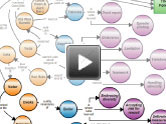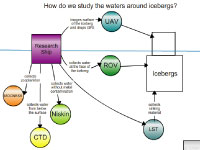|
|
|
||||||||||||||||||
About these Webinars: The ROLE Model webinars provide scientists with the opportunity to interact with educators and present their research in a non-traditional format - through multimedia concept maps created with the Concept Map Builder and presented through the Ocean Climate Interactive. [more]
About this Scientist:
Ben Twining is interested in the interactions between metals and planktonic organisms in marine and aquatic environments. Plankton play important roles in the global carbon cycle and form the base of most aquatic food webs. In many systems, the physiology and ecology of these organisms are influenced by the concentration, chemical speciation, and resulting bioavailability of trace metals. Conversely, biological processes such as cellular uptake and the production of organic ligands influence the geochemistry and fate of metals in these systems. [more]
About this Educator:
As Director of COSEE-OS, Annette deCharon leads the research and development of multimedia tools that are used to illustrate key connections in the ocean-climate system, and collaborative processes and models, like these webinars, that serve to promote ocean science education. She is also the lead developer of education and outreach materials for the NASA Aquarius sea surface salinity mission scheduled to launch in spring 2011. [more]














